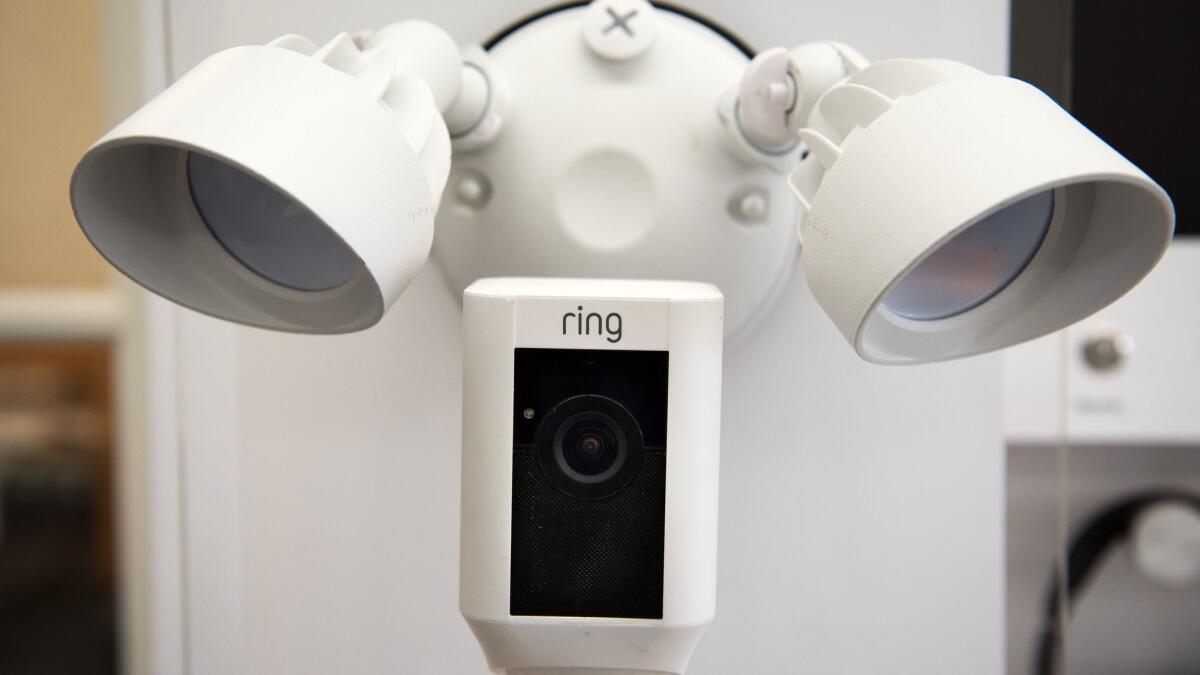By buying Ring and other smart home start-ups, tech’s biggest firms try to lure more people into their ecosystems

- Share via
Reporting from San Francisco — When Amazon.com approached Jason Johnson, founder and chief executive of August, nearly three years ago and asked to integrate his company’s internet-connected locks with a new device called the Amazon Echo, he thought it was a gimmick.
Smart speakers hadn’t yet taken off. Voice control was nascent. And August, which makes door locks that people can control from their phones, had already struck a chord with consumers. What could voice controls possibly add?
But Amazon was, of course, one of the world’s most successful businesses, so he figured it couldn’t hurt to see what the folks in Seattle could do.
Sitting in bed soon after, Johnson said to his Amazon Echo, “Alexa, ask August to lock the front door.” The front door clicked to lock. “And at that moment, I thought, ‘Oh, my god. This ability to control your house with your voice is brilliant.’”
He went out and bought four more Echoes.
In the early days of virtual assistants, companies such as Amazon, Google, and Apple thought smart speakers were the gateway to get consumers into their ecosystem, said Werner Goertz, research director at Gartner. But the strategy has shifted, with tech’s biggest players now casting a wider net — and relying on more gadgets — to get more households interacting with artificial intelligence systems such as Amazon’s Alexa, Apple’s Siri, Microsoft’s Cortana, and Google’s nameless virtual assistant.
There are now more than 30,000 ways in which Amazon’s Alexa cross-functions with third-party devices, according to Gartner’s estimates. And Amazon’s acquisition on Tuesday of the Santa Monica smart doorbell maker Ring supports the idea that, like the August smart lock, devices that consumers already use are seen as a wise path to lure people into a company’s ecosystem.
“The ultimate objective, of course, is to gain customer mindshare and keep users engaged with the ecosystem,” Goertz said. “Amazon wants you to buy stuff. Google makes money through search and ads, so it wants eyeballs. Apple wants you to buy iPhones and HomePods and to consume Apple music. All these companies are using the same tools to achieve different purposes.”
The first step, then, is to give potential customers a reason to even think about a company’s ecosystem. Not everyone needs a smart speaker in their home, but smart locks, thermostats and security cameras could be an easier sell. In fact, thermostats are one of the top-selling products in the connected home category, said Stuart Lombard, chief executive of thermostat maker Ecobee, because they’re easy to understand and relatively easy to use, and many markets offer energy rebates for people to upgrade their thermostats.
And as far as being a gateway product to a connected home, Lombard estimates that the Ecobee — which comes with Amazon’s Alexa Voice Service built in — is the first voice-enabled device in 50% of users’ homes.
“It’s not until customers have two to three devices that they think, how can these devices work together?” Lombard said. “Those are the things driving consumers, versus them asking what is the ecosystem that is going to do everything for me?”
With so many devices integrated across multiple virtual assistants — August’s door locks, for example, work with Amazon’s Alexa, Apple’s HomeKit, Google Assistant, Honeywell, IFTTT, Logitech, XFinity and Wing — the race now comes down to ease of use.
“Consumers have to do a lot of homework today to even understand what integrations work,” said Blake Kozak, a principal analyst at research firm IHS Markit. By having stronger partnerships with third-party device makers, or by owning them outright — as Amazon did when it reportedly spent more than $1 billion on Ring or when Google paid $3.2 billion for Nest Labs — the companies that control the ecosystem can have greater authority over the marketing and consumer education.
“Call it merchandising, if you will,” said Scott Curtiss, director of new product innovation at Avast, a company that keeps connected devices safe from hackers. “If I look at Comcast, I can get my cable, my phone, my mobile phone, and my home security, and they keep packing on more and more features. It’s seamless, easy, and all on one bill.”
It’s not too farfetched then to imagine a scenario in which customers can buy a smart home starter kit from Google or Apple. Or that an Amazon Prime membership might someday come with all the parts required to let customers play music, order groceries, control the temperature in their homes, control their lights, monitor activity at their front doors and remotely control the door locks.
Companies could keep customers engaged in their ecosystem by offering special deals or services related to proprietary devices — perhaps owners of Ring doorbells could someday gain the exclusive ability to unlock their doors so Amazon couriers can drop off packages inside.
A seamless smart home might not be that far off, according to analysts. But until then, customers are more likely to dip their toes into smart homes by first trying a Wi-Fi-enabled thermostat or a smart door lock, according to smart home technology makers.
“That’s why August and companies like Phillips Hue, we’re all playing Switzerland,” Johnson said. “We’re all playing with everybody. At the end of the day August wants to provide the best access control and be the best in our category. If we do that, consumers will choose our products.”
Depending on which devices those products integrate with — and which companies make the hardware — consumers might end up choosing Amazon, Google or Apple too.
Twitter: @traceylien







